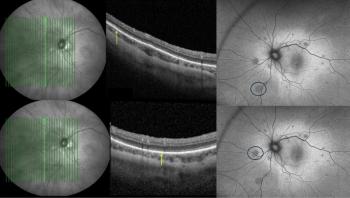
Ranibizumab treatment for DME shows positive results in study
Anti-vascular endothelial growth factor agent well-tolerated, met primary efficacy endpoint.
Results from 24 months of follow-up in RISE, one of two pivotal phase III studies investigating intravitreal ranibizumab (Lucentis, Genentech) for the treatment of diabetic macular oedema (DME), show that the anti-vascular endothelial growth factor (VEGF) agent was well-tolerated and met its primary efficacy endpoint, said Dr Dennis M. Marcus, at the 34th annual Macula Society meeting.
Dr Marcus is a vitreoretinal specialist in private practice, Southeast Retina Center, Augusta, Georgia, USA, and a principal investigator in RIDE (the second phase III pivotal trial) as well as a member of the Steering Committee for the phase III DME studies.
About the RISE trial
Visual acuity was measured at 1 week, 1 month, and monthly thereafter, and optical coherence tomography (OCT) measurement of central foveal thickness was performed monthly. The proportion of patients achieving a 15-letter or greater gain from baseline ETDRS BCVA at month 24 was analysed as the primary efficacy endpoint and showed rates in the ranibizumab 0.3 mg and 0.5 mg groups were significantly higher than in the control arm (44.8% and 39.2% versus 18.1%).
Results from secondary analyses considering other functional endpoints and anatomic assessments also favoured the ranibizumab arms, and the results of the safety analyses were consistent with data from prior large studies of ranibizumab for the treatment of age-related macular degeneration and retinal vein occlusion.
"The results from RISE support the efficacy of anti-VEGF therapy with ranibizumab for the treatment of DME, a condition for which there are no medications approved by the FDA, and the differences between the ranibizumab groups and the control arm at the 24-month primary efficacy endpoint are impressive," said Dr Marcus, who is also professor of clinical ophthalmology, University of South Carolina, Columbia, USA.
"It is also important to note that visual gains in the ranibizumab groups occurred quickly," he added. "At the first follow-up assessment at 1 week after the initial injection, there were already improvements in the ranibizumab group that were statistically significant compared with the sham group. Differences favouring ranibizumab over the controls in visual acuity and OCT thinning were maintained at every interval through 24 months."
At the 1-week visit, BCVA had improved by a mean of 5.4 and 4.6 letters in the ranibizumab 0.3 mg and 0.5 mg groups, respectively, compared with only 1.6 letters in the sham group. Data for the three groups from the 24-month visit showed mean improvements of 12.5, 11.9 and 2.6 letters, respectively, and at the same follow-up, a clinically significant loss in visual acuity (15 or more letters) occurred in only 2% of ranibizumab-treated patients compared with more than 10% of the controls, Dr Marcus said.
The functional benefits associated with ranibizumab treatment corresponded with reduction of macular oedema as demonstrated by OCT-measured thinning of the central fovea. A significant difference comparing both of the ranibizumab groups with sham was seen at 1 month (first follow-up OCT measurement) and was maintained at all successive timepoints. In the 24-month analysis, central foveal thickness decreased from baseline in the ranibizumab 0.3 and 0.5 mg groups by a mean of 250.6 μm and 253.1 μm, respectively, versus 133.6 μm in the sham injection group.
The protocol allowed for macular laser treatment beginning at 3 months based on the OCT findings and whether the investigator thought the patient was amenable to the intervention. Median number of macular laser treatments during the 24 months was analysed and showed a difference favouring the ranibizumab groups versus sham (0 versus 1).
"One potential criticism of the study is that rescue laser treatment overall was infrequently performed," Dr Marcus said. "However, in RISE, as in many other clinical trials investigating new treatment modalities for DME, the majority of enrolled patients had received prior laser and other DME therapies.
"Investigators often feel there is nothing much to gain from additional laser use, and this may well represent the current philosophies of practising retina doctors," Dr Marcus added.
The safety review showed incidences of adverse events associated with diabetic retinopathy, including retinal neovascularization, vitreous haemorrhage and retinal haemorrhage, were lower in the ranibizumab groups than in the control arm.
Serious ocular events occurring among the 250 ranibizumab-treated patients included one case of endophthalmitis, one retinal tear and two traumatic cataracts. The incidence of serious adverse events potentially related to systemic VEGF inhibition was 10.6% among controls, 5.6% for the ranibizumab 0.3 mg group, and 11.9% for ranibizumab 0.5 mg.
Special Contributor
Dr Dennis M. Marcus is a vitreoretinal specialist in private practice, Southeast Retina Center, Augusta, Georgia, USA, a prinicipal investigator in RIDE, a member of the Steering Committee for the phase III DME studies and professor of clinical ophthalmology, University of South Carolina, Columbia, USA. He can be reached by E-mail:
Dr Marcus has received funds from Genentech as a clinical investigator, consultant and advisory board member.
Newsletter
Get the essential updates shaping the future of pharma manufacturing and compliance—subscribe today to Pharmaceutical Technology and never miss a breakthrough.













































